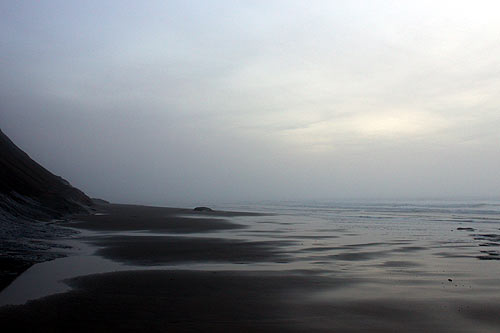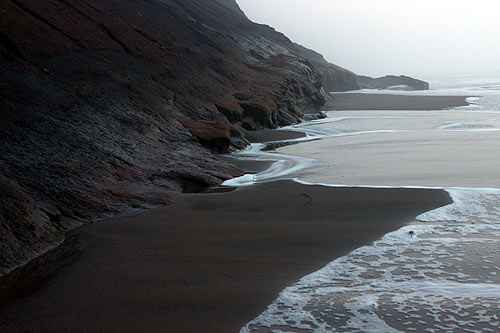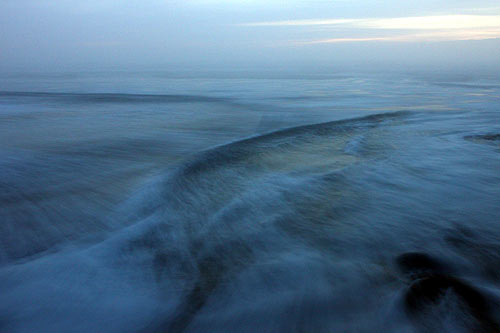I come across this very nice article today published online in the site called the BeachConnect.net, which as far as I can surmise is a travel oriented site for Oregon coast travel informations. This article, written by Andre' Hagestedt, is a very informative article about his effort at photographing the coastal waves completes with pictures and a video. The title of this article is "Anatomy of a Sneaker Wave on Oregon Coast: Time Lapse Video." The writing style is quite informal. Presumably aiming at young readers because it started with "Kids don't try this at home." I double kids will ever try them even without his warning. What I really think is that what he did is what nearshore beach scientists and engineers should be interested in pursuing! I copied here his whole article including pictures and the video. I did not find any copyright notice but please check BeachConnect.net for other beach travel infos.
Anatomy of a Sneaker Wave on Oregon Coast: Time Lapse Video
Published 11/16/2012
By Andre' Hagestedt
(Newport, Oregon) – Kids, don't try this at home. It's further proof just how dangerous Oregon coast sneaker waves can be – and how they can truly live up to their name.
You think you're safe on a certain beach, even during storm season. But you can be very wrong. Deadly wrong. My own experience at Moolock Beach, near Newport, is a perfect example.
Granted, I do know better. I know that a beach that is as chaotic as this one was in early November can spell trouble – even if it's a light kind of chaos. The keys here are two things. One: a beach that's rather small like Moolack, and not a big, broad sandy one, like most around Lincoln City, Cannon Beach or Seaside. And Two: you need only watch the waves a little while to see they sometimes come up way farther than the where the tide line normally is. Perhaps it's every minute or two, perhaps a bit longer. But if you see a big wave dart up the much farther than usual, to a place not considered, safe – even if it's once every five minutes – you're likely in trouble there.
But granted, on this day, Moolack Beach's nasty, scary sneaker waves took their time to appear. The tideline was way down the beach, normally about 100 feet or more from the cliffs. But every once in a while I'd see a wave get closer to the cliffs, perhaps within 20 feet. Not good, but it wasn't particularly terrifying, either.
Still, it stuck in my mind this may not be a good idea.
Then, after about about ten minutes, I'm wandering close to the cliff and a bit south of the cove-like entrance to Moolack, which offers another 60 feet or so of hiding space if you needed it. But I was hugging those cliffs, hell bent on my photo expedition. Sure enough, a massive sneaker wave comes barreling up from far down by that tideline, and I'm knee-deep in a wild wave that did threaten to knock me against those cliffs. There was nowhere to run.
You can see the difference in the top photo, from where the breakers usually were, and then see where they had just been, up by the cliffs.
Luckily, I only got my legs wet. But it was frightening. So I decided to stick to the cove after that, or at least near it. From there, I set up my camera on a tripod to automatically take time lapse shots of the beach action. I settle my equipment close to a small gravelly path – about 60 feet in from the cliffs, but still on the sand.
I go walking on the beach a bit as the camera does its thing, and a couple sneaker waves come up to the edges of the cliffs and even into the cove another 20 feet. There's still at least 30 feet between the crazed waves and my camera gear, though I have to walk a bit briskly away from those incoming watery intruders. This happens three or four times, when all of a sudden one really big one appears and is clearly going to reach my gear.
I run up the beach as fast as I can and manage to outrun all but a few inches of water, but it would've been enough to knock my camera and tripod into the big wave had I not grabbed it all just in time. Seriously, it was like an episode of “Mission: Impossible” or something, where doom was just a split second away.
I managed to hop onto a spot a couple inches higher, and the waves still splash my feet a tad.
Scary. Very scary. I did not expect that one, and I'm a seasoned beach bum. I figure that was just a freak one, but set my gear up just a little higher, just in case, about a foot back, and about two inches above where it was before. I'm thinking the gear has to be safe now.
Within minutes, another even bigger monster wave arrives – wow. Big surprise, nasty sneaker wave. This one trumps even the last one. It splashes up the path a bit and I still have to grab my equipment and run – again.
All this was caught in the time lapse photos; about 100 shots are in this video. So you can see what I encountered. This video should serve as further warning about crazed storm conditions and beach safety.
See the video below.
As the author indicated, he picked up the spot and set up the camera with tripod to do the kind of video recording. I am not entirely clear as to what was his purpose for doing this "photo expedition". I do think there should be scientific interests in his work. Because no one really know what might happen. Obviously what he had encountered was not what he expected either:
" . . . a massive sneaker wave comes barreling up from far down by that tideline, and I'm knee-deep in a wild wave that did threaten to knock me against those cliffs. There was nowhere to run."
Well what happened i's clearly what he should be prepared, because that's really something to be expected. And if I may add another layer of caution: I am not sure that he should be out there all alone, especially there doesn't seem to have anyone around. Anyway I do appreciate that he did it and provided us with the video and an interesting article. I hope all future safe ventures for him!



No comments:
Post a Comment